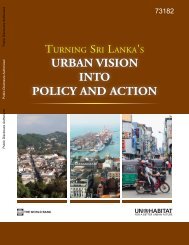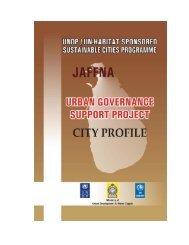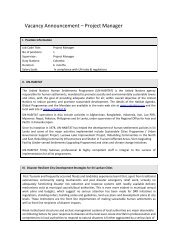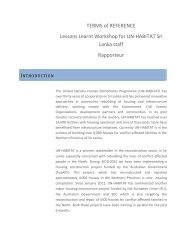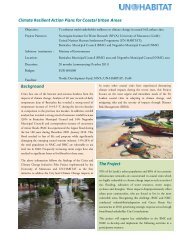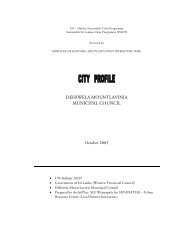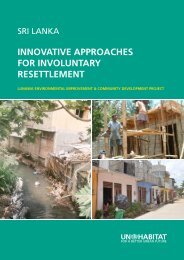Conference Proceedings : âJANASEVANAâ National ... - UN HABITAT
Conference Proceedings : âJANASEVANAâ National ... - UN HABITAT
Conference Proceedings : âJANASEVANAâ National ... - UN HABITAT
Create successful ePaper yourself
Turn your PDF publications into a flip-book with our unique Google optimized e-Paper software.
has been a feature of mature industrialization, the permanence and effective declines<br />
are now much more numerous.<br />
On the other hand, in developing countries, while the root cause may be present,<br />
viz. the change of industry or resource use and globalization changes in economic<br />
location, in developing countries we see impoverishment and implosion of cities and the<br />
corresponding throttling of growth and explosion of other cities.<br />
This economics must be seen in tandem with the globalization effects on urban<br />
areas. This is the rapid and continued rise of urbanization, more than half the<br />
population of the world lives in dense urban areas. And owing to the rise of poverty, the<br />
rise of slums or shanties or USS is increasing at even a greater rate. We are well on<br />
the way to becoming a Planet of Slums.<br />
6 INDIA<br />
As India is a close neighbor I would like to make a few remarks on the Indian<br />
situation.<br />
First the bleak aspect. With globalization, the problem of inner city breakdown<br />
has got worse in India. At the time that the WTO became operational India had 34<br />
million workers in the Textile Industry. Almost all these persons lived in city centers.<br />
This number has to drop very sharply to a fraction of this under global change. It means<br />
that the city centers have large unemployed but skilled pools of labor. There are many<br />
such industries rabnging from glass, leather to small industrial goods in India.<br />
Secondly the success. The successes in India are based on two key features.<br />
One is that the Indian Constitution requires Planning to be at the Local Government<br />
level. That is the highest permissible level of Planning. While it may be difficult for<br />
Centrist Planners to accept, it is actually quite workable for a private sector approach.<br />
The other key feature is the existence of a Federal Prize pot of over a trillion Rupees,<br />
regularly re-filled, called the Jawaharlal Nehru Trust Fund. The local based projects<br />
may apply for grants under this fund and a 50% grant is given quite regularly. There is<br />
intense competition for these grants by the private (including citizen) sector.<br />
For the development of a strong domestic sector this example may be studied.<br />
There is the further recent plan termed “The President’s Plan for the end of slums in five<br />
years”. It will take a couple more years at least for the contours of this solution to<br />
become plain. However it will probably become a third feature on which urban<br />
development will take place in India. This plan is based on a sophistication of the REEL<br />
program well known in Colombo.<br />
___________________ Dr Darin Gunesekera<br />
3




